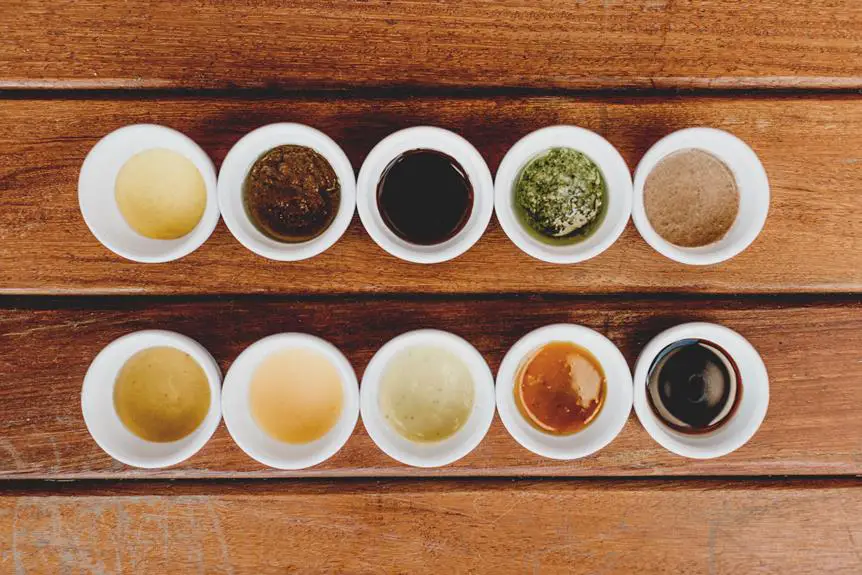Salmon, the mighty fish that navigates through rushing rivers and leaps upstream, is a popular choice for many health-conscious individuals. With its rich flavor and abundance of nutrients, it's no wonder why salmon has become a staple in diets worldwide.
However, like any food, there are pros and cons to consider. In this article, we will explore the various aspects of salmon, from its nutritional benefits to its environmental impact, helping you make informed decisions about including this fish in your diet.
Key Takeaways
- Salmon is a highly nutritious fish, rich in essential nutrients, high-quality protein, and omega-3 fatty acids.
- Omega-3 fatty acids found in salmon have numerous health benefits, including reducing the risk of heart disease, supporting brain health, and alleviating symptoms of depression and anxiety.
- Sustainable fishing practices, such as selective gear and catch limits, help maintain the health benefits of salmon and ensure the sustainability of fish populations.
- While there may be potential risks and environmental impacts associated with salmon consumption, choosing wild-caught salmon and limiting consumption can minimize these concerns.
Nutritional Benefits of Salmon
One of the main reasons why people love salmon is because it offers numerous nutritional benefits.
Salmon is a highly nutritious fish that's packed with essential nutrients. It's an excellent source of high-quality protein, which is essential for building and repairing tissues in the body. Additionally, salmon is rich in omega-3 fatty acids, which are known for their heart-healthy benefits. These fatty acids can help reduce inflammation, lower blood pressure, and decrease the risk of heart disease.
Salmon is also a good source of vitamins and minerals, including vitamin B12, vitamin D, selenium, and potassium. Vitamin B12 is important for maintaining healthy nerve cells and red blood cells, while vitamin D is crucial for bone health. Selenium is an antioxidant that helps protect cells from damage, and potassium is necessary for maintaining proper fluid balance and controlling blood pressure.
Furthermore, salmon is low in saturated fat and calories, making it an excellent choice for those watching their weight.
Omega-3 Fatty Acids in Salmon
Salmon is renowned for its high levels of omega-3 fatty acids, which have been linked to a range of health benefits. These essential fatty acids are known to support heart health, reduce inflammation, and improve brain function.
However, it's important to consider both the sustainability of fishing practices and the potential for mercury contamination when consuming salmon.
Health Benefits of Omega-3
Consuming omega-3 fatty acids found in salmon contributes to improving overall cardiovascular health. These essential fatty acids offer various health benefits that can positively impact one's well-being. Here are some key advantages of incorporating omega-3 into your diet:
- Reduces the risk of heart disease by lowering triglyceride levels
- Helps maintain healthy blood pressure by reducing inflammation and improving blood vessel function
- Supports brain health and cognitive function, especially in aging adults
- Alleviates symptoms of depression and anxiety by promoting the production of neurotransmitters
- Aids in reducing joint pain and stiffness, providing relief for individuals with arthritis
Sustainable Fishing Practices
Sustainable fishing practices, such as using selective gear and implementing catch limits, ensure the preservation of omega-3 fatty acids in salmon while maintaining healthy fish populations. These practices are crucial for the long-term sustainability of the salmon industry and the health benefits associated with consuming omega-3 fatty acids.
Selective gear, such as fish traps or hook-and-line fishing, allows fishermen to target specific species while minimizing the capture of non-target species. This helps to protect the population of salmon and other fish species from overfishing.
Implementing catch limits also plays a significant role in maintaining healthy fish populations. By setting regulations on the amount of fish that can be caught, fisheries can prevent overfishing and ensure that enough fish are left in the water to reproduce and sustain the ecosystem.
Ultimately, sustainable fishing practices are essential for preserving the omega-3 fatty acids in salmon and ensuring the long-term viability of the industry.
Potential Mercury Contamination
Mercury contamination in fish is a concern, but it doesn't negate the potential health benefits of consuming omega-3 fatty acids found in salmon.
While it's true that some salmon may contain trace amounts of mercury, it's important to note that the benefits of consuming omega-3 fatty acids outweigh the potential risks.
Here are some key points to consider:
- Omega-3 fatty acids are essential for brain health and development.
- They can help reduce inflammation in the body and lower the risk of chronic diseases such as heart disease and arthritis.
- The omega-3 fatty acids found in salmon are more easily absorbed by the body compared to plant-based sources.
- The American Heart Association recommends consuming fatty fish like salmon at least twice a week to reap the health benefits.
- It's possible to minimize mercury exposure by choosing wild-caught salmon, which generally contains lower levels of mercury compared to farmed salmon.
Health Risks Associated With Salmon Consumption
One should be aware of the potential health risks that come with eating salmon. While salmon is generally considered a healthy food due to its high omega-3 fatty acid content, there are some health concerns associated with its consumption.
| Health Risk | Description | Prevention |
|---|---|---|
| Parasitic Infections | Salmon can sometimes be infected with parasites, such as tapeworms or roundworms. These parasites can cause gastrointestinal issues and other complications. | Ensure salmon is properly cooked to kill any potential parasites. Freezing salmon at -4°F (-20°C) for at least 7 days can also kill parasites. |
| Antibiotic Resistance | Farmed salmon are often treated with antibiotics to prevent diseases. Over time, this can lead to the development of antibiotic-resistant bacteria, which can pose a risk to human health. | Choose wild-caught salmon, which is less likely to be treated with antibiotics. |
| Environmental Contaminants | Salmon can contain environmental contaminants such as polychlorinated biphenyls (PCBs) and dioxins. These substances are harmful to human health and can accumulate in the body over time. | Limit consumption of salmon to reduce overall exposure to these contaminants. Choose wild-caught salmon, which generally has lower levels of contaminants compared to farmed salmon. |
| Allergic Reactions | Some individuals may be allergic to salmon or develop an allergic reaction after consuming it. Allergic reactions can range from mild symptoms like hives or itching to severe reactions like anaphylaxis. | If you have a known allergy to fish, it is important to avoid consuming salmon or any other fish products. |
It is important to note that the health benefits of salmon, such as its high omega-3 fatty acid content, often outweigh the potential risks. However, it is always wise to be informed and make educated choices regarding salmon consumption to ensure optimal health and well-being.
Environmental Impact of Salmon Fishing
The environmental impact of salmon fishing raises concerns about overfishing and the potential disruption of ecosystems. Overfishing can deplete salmon populations, leading to imbalances in the marine food chain and affecting other species that depend on salmon for survival.
Additionally, the methods used in salmon fishing, such as nets and traps, can unintentionally capture and harm non-target species, further contributing to ecosystem disruption.
Overfishing Consequences
Salmon fishing has significantly depleted fish populations and harmed marine ecosystems. Overfishing of salmon has had serious consequences for both the environment and the species itself. Here are five key points to consider:
- Decline in fish populations: Overfishing has led to a significant decrease in salmon populations, impacting the delicate balance of marine ecosystems.
- Disruption of food chains: Salmon play a crucial role in the food chains of various marine species. Their decline can disrupt the entire ecosystem, affecting species that rely on them for food.
- Habitat destruction: Unsustainable fishing practices often involve damaging the habitats where salmon spawn. This further threatens their survival and the health of the ecosystems they inhabit.
- Genetic impact: Overfishing can lead to the loss of genetic diversity within salmon populations, making them more vulnerable to diseases and other environmental pressures.
- Impact on other species: Salmon fishing can inadvertently catch other marine species, leading to bycatch and potential harm to non-targeted organisms.
It is crucial to address the consequences of overfishing and implement sustainable practices to protect salmon populations and preserve marine ecosystems.
Ecosystem Disruption Risks
Due to unsustainable fishing practices and the disregard for marine ecosystems, salmon fishing poses significant risks of ecosystem disruption and environmental impact. When salmon are overfished, it disrupts the delicate balance of the ecosystem. Salmon play a crucial role in nutrient cycling, as they bring marine nutrients into freshwater systems. These nutrients are then consumed by other organisms, contributing to the overall health of the ecosystem.
Additionally, the decline of salmon populations can lead to a decrease in predator populations that rely on them for food. This can disrupt the entire food chain, affecting the abundance and diversity of other species.
Furthermore, the use of certain fishing methods, such as drift nets, can result in the unintentional capture of non-target species, known as bycatch, including endangered marine mammals and seabirds.
Cooking and Preparation Methods for Salmon
While there are numerous cooking and preparation methods for salmon, it's important to consider the specific flavors and textures each method can offer. Salmon is a versatile fish that can be cooked in various ways, allowing for different taste profiles and culinary experiences.
Here are five popular cooking and preparation methods for salmon:
- Grilling: Grilling salmon gives it a smoky and charred flavor, while keeping the flesh tender and moist. It's a great option for those who enjoy a slightly crispy exterior and a juicy interior.
- Baking: Baking salmon in the oven is a simple and foolproof method. It allows the fish to cook evenly and retain its natural flavors. This method is ideal for those who prefer a more delicate and milder taste.
- Pan-searing: Pan-searing salmon creates a crispy outer layer while keeping the inside moist and tender. This method is perfect for those who enjoy a combination of textures and flavors.
- Poaching: Poaching salmon involves gently simmering it in liquid, such as water or broth. This method helps to retain the fish's moisture and delicate flavors, resulting in a tender and succulent dish.
- Steaming: Steaming salmon is a healthy cooking method that preserves its natural flavors and nutrients. It produces a delicate and moist texture, making it an excellent choice for those who prefer a lighter and more delicate taste.
Farm-Raised Vs. Wild-Caught Salmon
One of the main considerations when comparing farm-raised and wild-caught salmon is their nutritional content. While both types of salmon are considered a healthy source of omega-3 fatty acids, there are some differences to take into account.
Farm-raised salmon is often higher in fat content compared to wild-caught salmon. This is due to their diet, which typically consists of fishmeal and fish oil. However, the fat composition in farm-raised salmon isn't necessarily a bad thing, as it can provide a rich source of omega-3 fatty acids.
On the other hand, wild-caught salmon tends to have a leaner profile with lower fat content. This can be attributed to the natural diet of wild salmon, which includes a variety of marine organisms. The lower fat content in wild-caught salmon may be appealing to individuals who are watching their calorie intake or prefer a leaner protein source.
In terms of nutritional value, both farm-raised and wild-caught salmon provide a good source of protein, vitamins, and minerals. However, wild-caught salmon is often praised for its higher levels of certain nutrients, such as vitamin D and selenium.
Ultimately, the choice between farm-raised and wild-caught salmon depends on personal preferences and priorities. While farm-raised salmon may offer a higher fat content and more affordable price, wild-caught salmon is often favored for its leaner profile and potentially higher nutrient content.
Availability and Cost of Salmon
The availability of salmon varies depending on the region and season, influencing its cost in the market. Here are some important points to consider:
- Seasonal availability: Salmon availability can vary throughout the year due to spawning and migration patterns. For example, wild-caught salmon is often more abundant during the summer months when they swim upstream to spawn.
- Geographical factors: The availability of salmon depends on the region. Coastal areas with access to the ocean tend to have more abundant supplies of fresh salmon compared to landlocked regions.
- Fishing regulations: Government regulations play a crucial role in managing salmon populations and ensuring sustainability. These regulations may limit the fishing season or impose quotas, affecting the availability of salmon.
- Demand and popularity: The demand for salmon has been steadily increasing due to its health benefits and versatile culinary uses. This high demand can impact both availability and cost, especially for certain varieties of salmon.
- Imported vs. domestic: Salmon is a globally popular fish, and it's often imported from countries like Norway and Chile. The availability and cost of imported salmon can be influenced by factors such as transportation costs and trade agreements.
Considering these factors, the availability and cost of salmon can vary significantly. It's essential for consumers to be aware of these dynamics to make informed choices when purchasing salmon.
Frequently Asked Questions
How Long Does It Take for Salmon to Reach Maturity?
Salmon reach maturity in about three to five years. The time it takes for them to mature can vary depending on their species and environmental conditions, but generally, it's within this range.
Can Salmon Be Consumed Raw?
Yes, salmon can be consumed raw. However, there are potential risks associated with eating raw fish, such as the presence of bacteria or parasites. It is recommended to properly handle and prepare raw salmon to minimize these risks.
Does the Color of Salmon Meat Affect Its Nutritional Value?
The color of salmon meat does not affect its nutritional value. Contrary to popular belief, both pink and red salmon are equally nutritious. It's like saying the color of apples changes their taste.
Are There Any Alternatives to Salmon That Provide Similar Health Benefits?
There are several alternatives to salmon that offer similar health benefits. These include sardines, mackerel, and anchovies. These fish are rich in omega-3 fatty acids and provide a good source of protein.
How Does the Taste of Farm-Raised Salmon Differ From Wild-Caught Salmon?
The taste of farm-raised salmon differs from wild-caught salmon due to differences in diet and environment. Farm-raised salmon may have a milder flavor, while wild-caught salmon tends to have a richer, more robust taste.








